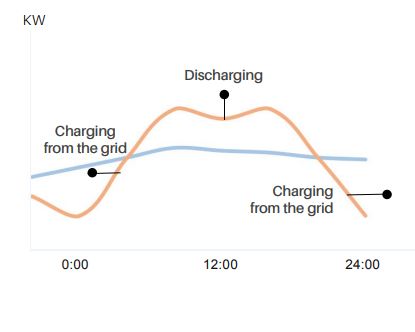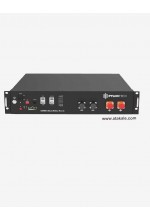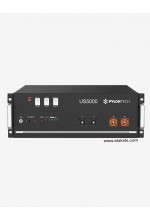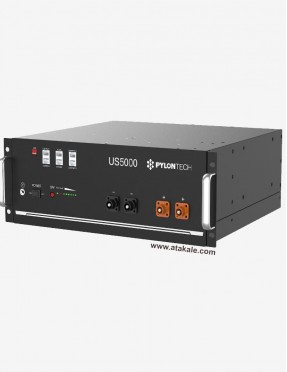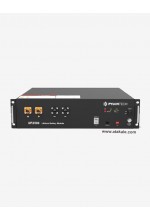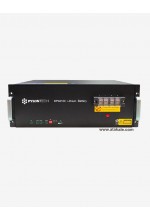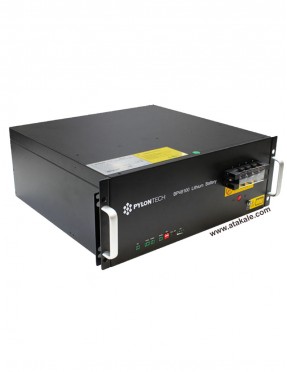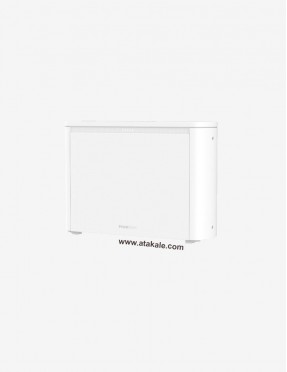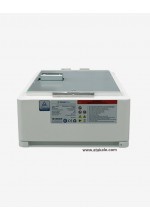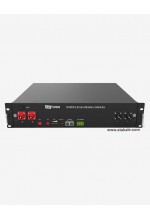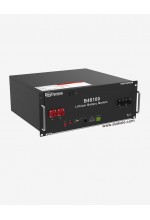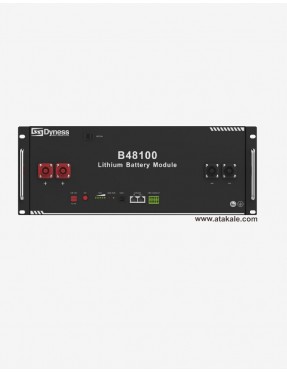Ürünümüz sevkıyattan önce kesinlikle kontrol edilmiştir. Cihazın dış kasasının şişmesi gibi herhangi bir anormal durumla karşılaşırsanız lütfen bizimle iletişime geçin.
Güvenliğinizi sağlamak için ürün kullanılmadan önce uygun şekilde topraklanmalıdır.
Doğru kullanımı sağlamak için lütfen ilgili cihaz arasındaki parametrelerin uyumlu ve eşleştiğinden emin olun.
Lütfen farklı üreticilere, farklı tip ve modellere ait, eski ve yeni pilleri bir arada kullanmayınız.
Ortam ve depolama yöntemi, ürünün kullanım ömrünü etkileyebilir, lütfen cihazın düzgün durumda çalışmasını sağlamak için çalıştırma ortamı talimatına uyun.
Uzun süreli depolama için, akü her 6 ayda bir yeniden şarj edilmeli ve elektrik yükü miktarı nominal kapasitenin %80'ini geçmelidir.
Lütfen akü tamamen boşaldıktan veya aşırı deşarj koruma modu etkinleştirildikten sonra 18 saat içinde şarj edin.
Teorik bekleme süresi formülü: T=C/I (T bekleme süresi, C pil kapasitesi, I toplam akım
Akü Yönetim Sistemi (BMS)
Voltaj Koruması Deşarj Halinde Düşük Voltaj Koruması: Deşarj sırasında herhangi bir akü hücresi voltajı veya toplam voltajı koruma değerinden düşük olduğunda, aşırı deşarj modu devreye girer ve akü sesli alarmı çalar. Akü sistemi dışarıya güç sağlamayı bıraktığında. Her bir hücrenin gerilimi anma dönüş aralığına geri döndüğünde, koruma sona erer.
Şarjda Aşırı Voltaj Koruması:
Şarj aşaması sırasında toplam voltaj veya herhangi bir pil hücresi voltajı nominal koruma değerine ulaştığında batarya şarj etmeyi durduracaktır. Toplam voltaj veya tüm hücreler nominal aralığa geri döndüğünde, koruma sona erer.
Şarjda Akım Koruması Aşırı Akım Koruması:
Şarj akımı 45A olduğunda, akım limiti koruma modu etkinleştirilir, akım 4A ile sınırlandırılır, koruma 10S geciktirme anma süresinden sonra kaldırılır. Akım 45A'dan daha yavaş olana kadar bu şekilde dolaşın.
Boşaltmada Aşırı Akım Koruması:
Boşaltma akımı, koruma değeri olan 55A'dan büyük olduğunda, pil sesli uyarısı verir ve sistem boşaltmayı durdurur. Nominal süre 1dk geciktikten sonra koruma kaldırılır.
Sıcaklık Koruması Şarjda Düşük/Aşırı sıcaklık koruması:
Şarj sırasında pilin sıcaklığı -5 ℃ +55 ℃ aralığını aştığında, sıcaklık koruması etkinleştirilir, cihaz şarjı durdurur. Sıcaklık nominal çalışma aralığına döndüğünde koruma sona erer
Boşaltmada Düşük/Aşırı sıcaklık koruması:
Boşaltma sırasında pilin sıcaklığı -20℃ +55℃ aralığını aştığında, sıcaklık koruması etkinleştirilir, cihaz dışarıya güç sağlamayı durdurur. Sıcaklık nominal çalışma aralığına döndüğünde koruma sona erer
Kısa devre koruması:
Pil kapatma durumundan etkinleştirildiğinde kısa devre oluşursa sistem 60 saniye boyunca kısa devre korumasını başlatır.
Kendi Kendini Kapatma:
Cihaz 72 saatin üzerinde herhangi bir harici yük ve güç kaynağına bağlanmadığında ve harici iletişimde bulunmadığında, cihaz otomatik olarak bekleme moduna geçer.
UYARILAR
Ürünümüz sevkıyattan önce kesinlikle kontrol edilmiştir.
Cihazın dış kasasının şişmesi gibi herhangi bir anormal durumla karşılaşırsanız lütfen bizimle iletişime geçin.
Güvenliğinizi sağlamak için ürün kullanılmadan önce uygun şekilde topraklanmalıdır.
Doğru kullanımı sağlamak için lütfen ilgili cihaz arasındaki parametrelerin uyumlu ve eşleştiğinden emin olun.
Lütfen farklı üreticilere, farklı tip ve modellere ait, eski ve yeni pilleri bir arada kullanmayınız.
Ortam ve depolama yöntemi, ürünün kullanım ömrünü etkileyebilir, lütfen cihazın düzgün durumda çalışmasını sağlamak için çalıştırma ortamı talimatına uyun.
Uzun süreli depolama için, pil her 6 ayda bir yeniden şarj edilmeli ve elektrik yükü miktarı nominal kapasitenin %80'ini geçmelidir.
Lütfen pili tamamen boşaldıktan veya aşırı deşarj koruma modu etkinleştirildikten sonra 18 saat içinde şarj edin.
Teorik bekleme süresi formülü: T=C/I (T bekleme süresi, C pil kapasitesi, I toplam akım
Kurulum Yeri
Kurulum konumunun aşağıdaki koşulları karşıladığından emin olun:
1) Alan tamamen su geçirmezdir
2) Zemin düz ve düzdür.
3) Yanıcı veya patlayıcı madde yoktur.
4) Ortam sıcaklığı 0°C ila 50°C aralığındadır.
5) Sıcaklık ve nem sabit bir seviyede tutulur.
6) Alanda minimum toz ve kir var.
7) Isı kaynağına olan mesafe 2 metreden fazladır.
8) İnverterin hava çıkışına olan mesafe 0,5 metreden fazladır.
9) Kurulum alanları doğrudan güneş ışığından korunmalıdır.
10) Akü modülü için zorunlu havalandırma gerekliliği yoktur, ancak lütfen kapalı alanda kurulumdan kaçının. Havalandırma aşağıdakilerden kaçınacaktır: yüksek tuzluluk, nem veya sıcaklık topraklama
Topraklama kabloları 10AWG veya üzeri sarı-yeşil kablolar olmalıdır. Bağlantıdan sonra, akü topraklama noktasından odanın veya kurulu yerin Toprak bağlantı noktasına olan direnç 0,1Ω'den küçük olmalıdır.
1) modülün yüzeyi ile rafın yüzeyi arasında doğrudan temas eden metal olmamalıdır tam izolasyon sağlanmalıdır. Boyalı raf kullanılıyorsa, ilgili yer boyayı kaldıracaktır.
2) modüllerin topraklama noktasına bir topraklama kablosu bağlayın ve kabini bu topraklama barasına bağlayınınız
1) Aküleri kabine koyun
2) 4 adet vidayı sürün
3) Akü modülleri arasındaki kabloları bağlayın
4) Kabloları invertöre bağlayın
Sorun giderme.
dayalı sorun belirleme
1) Akünün açılıp açılmayacağı
2) Pil açıksa, kırmızı ışığın kapalı olduğunu, yanıp söndüğünü veya yandığını kontrol edin.
3) Kırmızı ışık yanmıyorsa, pilin şarj edilip edilemeyeceğini kontrol edin. Olası koşullar: 1) Pil açılamıyor, AÇIK konuma getirin ve kırmızı SW'ye basın, ışıkların hepsi yanmıyor veya yanıp sönmüyor.
a) Kapasite çok düşük veya modül aşırı boşalmış. çözüm: 48-53,5V voltaj sağlamak için bir şarj veya invertör kullanın. Pil başlayabiliyorsa, modülü şarj etmeye devam edin ve pil günlüğünü kontrol etmek için izleme araçlarını kullanın.
Akü terminal voltajı ≤45Vdc ise, SOH'den etkilenmemek için modülü yavaşça şarj etmek için lütfen ≤0.05C kullanın. Akü terminal voltajı >45Vdc ise, şarj etmek için ≤0.5C kullanabilir.
Pil başlayamıyorsa, pili kapatın ve onarın.
2) Pil açılabilir, ancak kırmızı ışık yanıyor ve şarj olmuyor veya deşarj olmuyor. Kırmızı ışık yanıyorsa, sistem anormaldir, lütfen değerleri aşağıdaki gibi kontrol edin.
b) Sıcaklık: 60°C'nin üzerinde veya -10°C'nin altında pil çalışmayabilir. Çözüm: Pili 0°C ile 50°C arasındaki normal çalışma sıcaklığı aralığına taşımak için
c) Akım: Akım 90A'i geçerse pil koruması devreye girer. Çözüm: Akımın çok büyük olup olmadığını kontrol edin, varsa güç kaynağı tarafındaki ayarları değiştirin.
32
d) Yüksek Voltaj: Şarj voltajı 54V'un üzerinde ise akü koruması devreye girer. Çözüm: Güç kaynağı tarafındaki ayarları değiştirmek için voltajın çok yüksek olup olmadığını kontrol edin. Ve modülü boşaltın.
e) Düşük Voltaj: Akü 44,5V veya altına düştüğünde akü koruması devreye girer. Çözüm: Kırmızı ışık sönene kadar pili şarj edin.
f) Hücre voltajı yüksek. Modül voltajı 54V'tan düşük, SOC LED'i tamamen yanmıyor. Deşarj olduğunda modül koruması kaybolur. Çözüm: Modülü 53-54V ile şarj edin veya sistem döngüsünü koruyun. BMS, döngü sırasında hücreyi dengeleyebilir.
3) Kırmızı LED açıkken şarj ve deşarj yapılamıyor. Sıcaklık 0
50 derecedir. Şarj etmek için şarj cihazını kullanın, mümkün değil. Boşaltmak için yük kullanın, mümkün değil.
g) Kalıcı koruma altındadır. Tek hücre voltajı 4.2'den yüksek veya 1.5'ten düşük veya sıcaklık 80 dereceden yüksek. Çözüm: Modülü kapatın ve onarım için yerel distribütörünüzle iletişime geçin.
4) Kırmızı LED yanmadan şarj ve deşarj yapılamıyor. Sıcaklık 0
50 derecedir. Şarj etmek için şarj cihazını kullanın, mümkün değil. Boşaltmak için yük kullanın, mümkün değil.
h) Sigorta bozuk. Çözüm: Modülü kapatın ve onarım için yerel distribütörünüzle iletişime geçin.
LifePo4 Bakımı
• Müşteri aküyü teslim aldığında, öncelikle temel işlevi kontrol etmeli ve nakliye sırasında herhangi bir hasar oluşmadığından emin olmalıdır. Lütfen lifepo4 voltajını, şarj işlevini, deşarj işlevini ve görüntüleme işlevini test edin; Herhangi bir anormallik varsa lütfen kurulumu durdurun ve hemen bize bildirin. akünün kurulum kılavuzuna göre taktıktan sonra, ilk kez kullanmadan önce aküyü tamamen şarj edin. akü , üç ila beş kez tam olarak şarj edilip boşaldığında maksimum kapasitesine ulaşacaktır.
• Ömürlerini uzatmak için aküleri kapasiteleri düşükken şarj edin. Bu süre içinde piller şarj edilmezse ve uzun süre eksik kalırsa akü ömrü olumsuz etkilenecektir. Bu aküler uzun süre kullanılmayacaksa, yarı kapasitede tutun ve aküyü iki ayda bir, her seferinde bir saat yüzer şarj edin.
• Batarya kuru, temiz ve iyi havalandırılan bir alana kurulmalı, bu arada tutuşma kaynaklarından ve yanıcı malzemelerin yakınından kaçınılmalıdır. Şarj sırasında yükün bağlantısını kestiğinizden (yani elektrikli ekipmanı kapattığınızdan) emin olun.
• Pilin çalışma sıcaklığı 41–104°F'dir. (Optimum çalışma sıcaklığı 59–95°F'dir.) Bu sıcaklık aralığının dışında pilin performansı değişebilir. Bu şartlar altında kapasitenin veya ekipmanın çalışma süresinin değişmesi normaldir.
• Akü kutusunu organik çözücülerle temizlemekten kaçının.
• Bir kaza olursa, yangını söndürmek için karbondioksit kullanmayın; bunun yerine, söndürmek için karbon tetraklorür veya kum kullanın.
• Lifepo4 bir sarf malzemesidir ve kullanım ömrü sınırlıdır. Lütfen pil kapasitesi nominal kapasitenin %50'sinden düşük olduğunda aküyü değiştirin.
LifePo4 Akülerin paralel olarak şarj edilme voltajı
LiFePO4 aküler paralel olarak bağlarken, hizmete almadan önce lütfen her bir pilin 0.1V aralığında olduğundan emin olun, Bu, aküler arasındaki dengesizlik olasılığını en aza indirecektir. 12V LiFePO4 akü şarj ediyorsanız, şarj voltajı 14V – 14,2V arasında olmalıdır. 24V aküleri paralel olarak şarj ederken, şarj voltajı 28V – 28.4V olmalıdır. 36V lityum akü paralel olarak şarj etmek için 42V – 42,6V voltaj gerekir. Son olarak, 48V LiFePO4 aküleri şarj etmek için 56V – 56.8V voltaj parametreleri gerekir. Aşağıda, her sistem voltajı için voltaj gereksinimlerini gösteren bir özet içeren bir tablo bulunmaktadır.
Sistem Gerilimi ........Şarj Voltajı
12V.......................14V – 14.2V
24V....................... 28V – 28,4V
36V.......................42V – 42.6V
48V.......................56V – 56.8V
Voltaj parametreleri hem CC hem de CC-CV şarj profilleri için geçerlidir. Şarj cihazınızın voltajı tabloda listelenenlerden daha düşükse, akünüze zarar vermez, ancak yetersiz şarj olur ve akünün tam nominal kapasitesini sağlamaz. Şarj cihazınızın voltajları yukarıdaki tablolarda listelenenlerden daha yüksekse, BMS akünün bağlantısını kesebilir ve yeniden bağlanmak için yükü kaldırmanız gerekebilir. Bu rahatsızlıktan kaçınmak için şarj cihazını değiştirmenizi ve yüksek kaliteli bir LiFePO4 akü şarj cihazına yatırım yapmanızı öneririz.
lifePo4 Akülerin Seri olarak şarj edilmesi
LifePo4 akülerin seri şarj edilmesi
Aküleri seri olarak bağlarken, hizmete almadan önce lütfen her akünün birbirinden 50mV (0,05V) dan fazla olmadığından emin olun. Bu, aküler arasında bir dengesizlik olasılığını en aza indirecektir. Akülerinizin dengesi bozulursa, herhangi bir akü voltajı setteki başka bir aküden 50mV (0,05V) ise, yeniden dengelemek için her aküyü ayrı ayrı şarj etmelisiniz. Dengesizliği önlemek için her aküyü periyodik olarak ayrı ayrı şarj edebilirsiniz. LiFePO4 aküleri seri olarak şarj ederken, hücrelerin dengeli kalmasını sağlamak için her akü ayrı ayrı şarj eden çok sıralı bir şarj cihazı kullanmak en iyisidir. Sisteminizi bir bütün olarak şarj etmek istiyorsanız, 24V akü LiFePO4 şarj cihazı veya 48V pil LiFePO4 şarj cihazı da kullanabilirsiniz.
Tabii unutmayalım, bu işlemi her şarj ederken uygulamak gerekecektir. Buda pratik olmayacağından, aküleri seri bağlamayınız, akülerinizi tamamen kaybetmenizi sebep olur.
Voltaj parametreleri hem CC hem de CC-CV şarj profilleri için geçerlidir. Şarj cihazınızın voltajı tabloda listelenenlerden daha düşükse, pilinize zarar vermez, ancak yetersiz şarj olur ve pilin tam nominal kapasitesini sağlamaz. Şarj cihazınızın voltajları yukarıdaki tablolarda listelenenlerden daha yüksekse, BMS akünün bağlantısını kesebilir ve yeniden bağlanmak için yükü kaldırmanız gerekebilir. Bu rahatsızlıktan kaçınmak için şarj cihazını değiştirmenizi ve yüksek kaliteli bir LiFePO4 pil şarj cihazına yatırım yapmanızı öneririz.
LIFEPO4'ün Akıllı invertör veya Solar şarj kontrol cihazıyla şarj edilmesi nasıldır
Aşağıda, LiFePO4 aküleri şarj etmek için bir invertör/şarj cihazı veya şarj kontrol cihazı kullanırken temel, tipik şarj cihazı girişleri bulunmaktadır. Birçok invertör/şarj cihazı ek parametreler gerektirir,
Şarj Kademesi................12V Sistem.................24V Sistem...................36V Sistem.............48V Sistem
Bulk Şarj Voltajı..................14V – 14.6V.................28V – 29.2V.................. 42V – 43.8V.............56V – 58.4V
Absorption Voltaj................14V – 14.6V.................28V – 29.2V...................42V – 43.8V.............56V – 58.4V
Absorption Süresi................0- 6 dakika................0- 6 dakika...................0- 6 dakika.............0- 6 dakika
Float Voltajı......................13.8V ± 0.2V...............27.6V ± 0.2V..................41.4V ± 0.2V...........55.2V ± 0.2V
Düşük Voltaj Kesme.............11V..........................22V............................33V......................44V
Yüksek gerilim kesme..........14.6.........................29.2V.........................43.8V....................58.4V
LifePo4 Aküleri Hangi Şarj cihazı kullanmalıyız
LiFePO4 pilleri nasıl şarj edilir? Müşterilerimizden aldığımız en yaygın sorulardan biri budur. Cevap basit: Elbette bir LiFePO4 pil şarj cihazı kullanın. LiFePO4 pilleri şarj ederken, tipik olarak LiFePO4'ün gerektirdiğinden daha yüksek voltajla tasarlanmış diğer lityum iyon kimyaları için tasarlanmış bir şarj cihazı kullanmadığınızdan emin olun. Lityum demir fosfatı şarj etmek için kurşun asitli bir pil şarj cihazının kullanılıp kullanılamayacağı sıklıkla sorulur. Kısa cevap, voltaj ayarları LiFePO4 pillerin kabul edilebilir parametreleri içinde olduğu sürece evet.
LiFePO4 şarj cihazını kullanmadan önce şarj cihazınızın kablolarının yalıtıldığını ve kırılmadığını kontrol edin. İyi bir bağlantı ve optimum iletkenlik sağlamak için şarj cihazı terminal konektörleri temiz olmalı ve akü terminalleriyle doğru şekilde eşleşmelidir.
LifePo4 Akülerin şarj gerilim başlangıcı
LiFePO4 aküler tamamen boşalmamışsa, her kullanımdan sonra şarj edilmelerine gerek yoktur. LiFePO4 aküler , kısmi şarj durumunda (PSOC partial state of charge ) bırakıldığında zarar görmez. LiFePO4 akülerinizi her kullanımdan sonra veya %80 DOD'a (%20 SOC) kadar deşarj olduklarında şarj edebilirsiniz. Pil Yönetim Sistemi BMS), düşük voltaj (voltaj 10V olacaktır) nedeniyle akünün bağlantısını keserse, yükü kaldırın ve hemen bir LiFePO4 pil şarj cihazı kullanarak şarj edin.
Lityum Demir Fosfat Aküler Şarj edilem sıcaklığı
LiFePO4 aküler 0°C ila 45°C (32°F ila 113°F) arasında güvenli bir şekilde şarj edilebilir. LiFePO4 aküler , sıcak veya soğuk sıcaklıklarda şarj olurken voltaj için sıcaklık telafisi gerektirmez. Tüm LiFePO4 aküler , düşük ve yüksek sıcaklıklardan koruyan dahili bir BMS ile birlikte gelir. Düşük sıcaklık nedeniyle BMS bağlantısı kesilirse, BMS'nin yeniden bağlanması ve şarj akımını kabul etmesi için akünün ısınması gerekir. Akünün'nin bağlantısı yüksek sıcaklık nedeniyle kesilirse, BMS'nin aküyü şarj etmeyi kabul etmesi için akünün soğuması gerekir. BMS düşük sıcaklık ve yüksek sıcaklık kesme ve yeniden bağlanma değerleri için lütfen özel akünüzün veri sayfasına bakın.
LT lityum pillerin şarj ve deşarj sıcaklığı -20°C ila 60°C'dir. Bazı Düşük Sıcaklık (LT) Lityum Piller, Kanada'nın soğuk iklimleri için tasarlanmış, soğuk hava koşullarına uygundur. Bu piller, şarj cihazından güç çeken tescilli teknolojiye sahip yerleşik bir ısıtma sistemine sahiptir. Ek bileşen gerekmez. Tüm ısıtma ve şarj işlemi tamamen sorunsuzdur. Isıtma sistemi, 0°C'nin altında şarj etmeye çalışıldığında otomatik olarak devreye girer ve ihtiyaç kalmadığında otomatik olarak devre dışı kalır. Isıtma sistemi gücü pilden değil, şarj cihazından alır ve lityum akünün kendi kendine boşalmamasını sağlar ve size güç sağlar. LT lityum akü LiFePO4 şarj cihazına takmanız yeterlidir; gerisini dahili ısıtma ve izleme sistemleri halleder.
LIFEPO4 Aküler Kurşun Asit Şarj cihazlarıyla şarj edilirmi
Çoğu kurşun asitli akü şarj cihazı, uygun voltaj yönergeleri dahilinde oldukları sürece LiFePO4 akülerle kullanılabilir. AGM ve Jel algoritmaları tipik olarak LiFePO4 voltaj gereksinimlerine girer. Sulu akü şarj algoritmalarının voltajı genellikle LiFePO4 şarj gereksinimlerinden daha yüksektir ve bu da BMS'nin bağlantısının kesilmesine neden olur. Böyle bir durumda, şarj cihazınızı bir LiFePO4 şarj profiliyle değiştirmek genellikle iyi bir uygulamadır. BMS aküyü koruduğu için kurşun asitli şarj cihazlarının kullanılması tipik olarak aküye zarar vermez.
Düşük voltaj nedeniyle BMS bağlantısı kesilirse, şarj cihazı LiFePO4'ü şarj etmek için kabul edilebilir şarj parametrelerine sahip olsa bile kurşun asitli akü şarj cihazı BMS'yi yeniden bağlayamayabilir. Bunun nedeni, BMS'nin bağlantısı kesildiğinde, bir voltmetrede 0V okuyacağı için lityum pilin voltajı olmayacak, kurşun asitli şarj cihazlarının ise şarjı başlatmak için akünün bir voltaj okumasını gerektirmesidir. Akü 0V okuyorsa, kurşun asitli akü şarj cihazı bir akü bağlı olduğunu ve şarj olmaya başlaması gerektiğini anlayamayacaktır. Bu, bazı düşük kaliteli lityum şarj cihazları için de geçerlidir. Yüksek performans ve uzun ömür sağlamak için her zaman yüksek kaliteli bir LiFePO4 şarj cihazına yatırım yapmanız önerilir.
DC DC konvertörle ve Alternatörle LifePo4 akülerin şarj edilmesi
Alternatörün kalitesine bağlı olarak, LiFePO4 akülerin değişiklik yapmadan şarj etmek iyi sonuç verebilir. Bununla birlikte, zayıf voltaj regülasyonu olan düşük kaliteli alternatörler, BMS'nin LiFePO4 akülerinin bağlantısını kesmesine neden olabilir. BMS akülerin bağlantısını keserse, alternatör hasar görebilir. LiFePO4 akünüzü ve alternatörünüzü korumak için lütfen uyumlu bir yüksek kaliteli alternatör kullandığınızdan veya bir voltaj regülatörü taktığınızdan emin olun. Ev tipi küçük enerji depolama da dahil olmak üzere akülerinizi güvenli ve etkili bir şekilde şarj etmek için DC'den DC'ye şarj cihazı da kullanabilirsiniz. Bir alternatörle lityum şarjı söz konusu olduğunda, DC'den DC'ye şarj cihazı takmak önerilen seçenektir.
Lityum Demir Fosfat Aküler Kurşun asit akü şarj cihzlarıyla şarj edilirmi
Çoğu kurşun asitli akü şarj cihazı, uygun voltaj yönergeleri dahilinde oldukları sürece LiFePO4 akülerle kullanılabilir. AGM ve Jel algoritmaları tipik olarak LiFePO4 voltaj gereksinimlerine girer. Islak hücre veya sulu akü şarj algoritmaları için voltaj genellikle LiFePO4 gereksinimlerinden daha yüksektir, bu da BMS'nin şarj döngüsünün sonunda pili ayırmasına ve şarj cihazının bir hata kodu göstermesine neden olabilir. Böyle bir durumda, şarj cihazınızı değiştirmek genellikle iyi bir uygulamadır. BMS aküyü koruduğu için kurşun asitli şarj cihazlarının kullanılması aküye zarar vermez.
Sako LiFePo4 Enerji Depolama Sistemi
15 Sene Dizayn Ömrü 6000 Çevrim
RS 485 ,RS422, RS 232, CAN Haberleşme
Eklenebilir, Yönetilebilir, Parallel Op
4kw-1000kw Enerji Depolama Sistemi
Dış ortam iç ortam montajına uygun
Solar ,Energy, Rüzgar En., UPS, Marine
Moduler dizayn, İnvertör Haberleşme
Ev, İşyeri, Telekom ve Santral uygulaması
Akü Voltaj Aralığı
Akım Kapasite Aralığı
Ömür Döngü Sayısı
3,2V-400V
1,3Ah-10000Ah
5000-12000cyle
Gümrük tarife GTIP :85065090 Çin malı
Sako, şebekeden bağımsız güneş enerjisi invertör, off-grid invertör, solar motor sürücü, lityum demir fosfat akü, güneş paneli, enerji depolama sistemleri üretmektedir. 1993 yılında kurulan SAKO, araştırma ve geliştirmeyle uğraşan profesyonel bir üreticidir. Yüksek kaliteli enerji ve güneş enerjisi ürünlerinin satışı ve servisidir. Dünyanın bir çok ülkesinde satılmakta ve ofisi bulunmaktadır. SAKO güneş enerjisi sistemi enerji depolama sistemleri tüm temel bileşenlerini kednisi ürettiğimiz için maliyet kontrolü ve kalite kontrol avantajına sahiptir. Müşterilerin SAKO'dan tek noktadan alışveriş yapabilir ve zengin teknik desteğinden faydalanabilir. türkiyenin bir çok yerinde ürün garanti ve servisleri mevcuttur. CAN/RS485/RS232 (opsiyoneldir. Ücrete Dahil değildir)
Sako Marka Lityum akü ve enerji depolama ürünleri BYD marka hücrelerle yapılmaktadır.
Siparişiniz esnasında Sako ürünlerinde güncelleme yaptığında ,yeni model ve özellikte ürün satmaya başladığında, size en son üretimi ve satışı yapılan ürün gönderilecektir.
Profesyonel Proje Ürün Gurubudur. Ürün sipariş edildiğinde sizin için 7 gün içinde üreticiden /ithalatçıdan tedarik edilerek özel sipariş olarak gönderilecektir. Aceleniz var ise lütfen iletişme geçerek stok öğrendikten sonra satın alınız. Son Kullanıcı Tüketici Elektronik Ürünü Değildir. Satın Alma Şartları , değişim , iade ve garanti şartları tüketici korunma haklarınını içermez. Ticaret Kanunu hükümleri geçerlidir. Sadece bayi ve tüccarlara satış yapılmaktadır. Satın alan kişi bu ürünü kullanmaya yeterli bilgisi ve eğitimi yok ise almamasını tavsiye ediyoruz.
24/48VDC serisi Lityum enerji depolama sistemi
Sako'nun yeni enerji depolama ürünlerinden biridir, çeşitli ekipman ve sistemler için güvenilir gücü desteklemek için kullanılabilir. Özellikle yüksek güç, sınırlı kurulum alanı, sınırlı yük uygulamalar için uygundur.
24/48VDC serisi, voltaj, akım ve sıcaklık dahil olmak üzere hücre bilgilerini yönetebilen ve izleyebilen yerleşik BMS akü yönetim sistemine sahiptir. Dahası, BMS, çevrim ömrünü uzatmak için hücrelerin şarj ve deşarjını dengelemektedir.
Daha büyük kapasite ve daha uzun güç destekleme süresi gereksinimleri için kapasiteyi ve gücü paralel olarak genişletmek amacıyla birden fazla depolama ünitesi paralel olarak bağlanabilir. Burada dikkat edeceğiniz nokta Lityum akünün kapasitesi bağlayacağınız Solar Inverterden daha yüksek olmalıdır.
Özellikler:
-Hepsi bir arada sistem, 48V lityum pil modülü, 6kw hibrid solar invertör, Solar/AC Şarj Cihazı ile dahili olarak inşa edilmiştir.
-Kurulumu kolay
- İletişim protokolüne sahip dahili akıllı BMS
- LiFPO4 hücreleri döngü süresi 6000 çevrime kadar şarj/deşarj döngüsü
- Her Modül 120A mppt Solar şarj ve AC Şarj fonksiyonuna sahiptir
-Tüm gelişmiş koruma sistemleri paket içeriğine dahil edilmiştir.
- %80 DOD, 5 yıl garanti, 10+ yıl ömürlü tasarım
◆
Sako Enerji Depolama ürünleirnin tamamı toksik değildir, kirletici değildir ve çevre dostudur.
◆ Katot malzemesi, güvenlik performansı ve uzun çevrim ömrü ile LiFePO4'ten yapılmıştır.
◆ Akü yönetim sistemi (BMS), aşırı deşarj, aşırı şarj, aşırı akım ve yüksek/düşük sıcaklık gibi koruma fonksiyonlarına sahiptir.
◆ Sistem otomatik olarak şarj ve deşarj durumunu yönetebilir ve her bir hücrenin akım ve voltajını dengeleyebilir.
◆ Esnek konfigürasyon, kapasiteyi ve Gücü artırmak için birden fazla akü modülü paralel bağlanabilir.
◆ Otomatik soğutma modunun benimsenmesi, sistemin tüm gürültüsünü hızla azalttı. Modül, rafta şarj edilmeden 6 aya kadar daha az kendi kendine deşarj özelliğine sahiptir, hafıza etkisi yoktur, sığ şarj ve deşarjda mükemmel performansa sahiptir.
◆ Çalışma sıcaklığı aralığı -10°C ila 50°C arasındadır (şarj 0°C~ 50°C, boşaltma -10°C~ 50°C) ve mükemmel boşaltma performansı ve çevrim ömrü vardır.
Ana Özellikler
- 12,24V, 48V LiFePO4 farklı kapasite paketleri vardır.
-CATL, BYO veya GOTION gibi üst düzey lifepo4 hücre üreticilerinin ürünleriyle üretilmiştir.
-Hücre ömür döngü süreleri: 3000 çevrimden fazladır. Tasarımömürleri 5 yıl garantisi ise ,2+ yıl ömürlüdür.
- Performansı optimize etmek için akıllı BMS sistemi ile Dahili 1.2A hücre dengeleme kapasitene sahiptir, tüm hücreleri kısa sürede dengeleyebilir.
- Maksimum deşarj akımı 200A'ya kadar çıkabilir. Güneş enerji sistemleriyle uyumludur. -
-4mA kadar düşük mükemmel bekleme öz tüketimi vardır. Yüksek enerji yoğunluk, küçük boyut ve düşük ağırlık avantajlarıyla özel tasarımdır. -
-Duvara monte tasarım, kolay Kurulum.
- LCD ekran veya iletişim için isteğe bağlıdır (CAN/RS4851RS232).
SAKO ürünleri istikrarlı kalitesi, rekabetçi fiyatı ve iyi hizmeti nedeniyle çok popülerdir. Bölgenizdeki Atakale mağazalarından temin edebilrisiniz. Ayrıca OEM/ODM siparişlerini de kapaınızda teslimatle karşılıyoruz. İster kataloğumuzdan güncel bir ürün seçin ister uygulamanız için mühendislik yardımı isteyin, kaynak bulma gereksinimleriniz hakkında ekibimizle konuşabilirsiniz. Zengin deneyimine, güçlü Ar-Ge'sine, sıkı kalite kontrol sistemlerine, yaratma ruhuna dayanarakAtakale'nin size memnun güneş enerjisi ürünleri ve hizmeti sunabileceğine güvenin.
Hem SAKO firması hem de ürünleri ihracata uygun niteliktedir. SAKO, IS09001, 15014001, OHAS18001, TUV, CE, CB, CQC sertifikalarını almıştır. Müşterinin PSI uygulamasına da yardımcı olmaktadır. COC, SONCAP, SASO, SABRE, vb.
Küçük ve Orta Kapasiteli Yedekleme
Baz İstasyonu Güç Çözümleri geniş kapsama alanı gerektirir, kablosuz baz istasyonları genellikle geniş alanlara dağıtılır, cihaz tüketimi azdır ve şebeke arıza süresi kısadır. Sık elektrik kesintilerinden kaynaklanan sorunlar için küçük baz istasyonundaki her cihazla tek tek akü yapılandırması önerilir, ayrıca küçük boyutu ve kolay montajı ile akülerimiz dar senaryoda, özellikle kule, duvara asma ve direk tutma cihazı, aynı zamanda, uzaktan izleme ve yönetim sistemi aracılığıyla birleşik yönetim ve kolay bakım sağlar
Büyük Kapasiteli Yedek Güç Çözümleri
Cep telefonu baz istasyon veya marjinal istasyon uygulamalarında , cihazlar konsantre veya çok uzağa yerleştirilir. Yüksek tüketim veya uzun mesafe nedeniyle ana güç kesintisi olduğunda, her ikisi de daha uzun süre için daha büyük kapasiteli yedek güç sistemlerine sahip merkezi yedek güç çözümleri gerektirir ve sürekli çalışmayı sağlamak için sahaya birleşik yedek güç sağlamak için pilimiz gerçek talebe göre kademeli hale getirilebilir uzun süre, aynı zamanda, ağ yönetimi uzaktan izleme yoluyla, birleşik yönetim ve kolay bakım elde edin.
Kapsamlı avantajlar
-Düşük Toplam Sahip Olma Maliyeti
-Uzun yaşam döngüleri, ortalama yaşam beklentisi maliyetini azaltır;
-Yüksek enerji verimliliği, tedarik maliyetlerini azaltır;
-Küçük boyut, aynı kapasite için daha az alana ihtiyaç duyar;
-Bakım gerektirmemesi daha düşük maliyet getirir.
-Çevreye Yüksek Uyarlanabilirlik
-Çalışma sıcaklığı aralığı -10 ℃ ila 50 ℃ arasındadır;
-Sık kesintiler için uygundur ve hafıza etkisi yoktur;
-Toza dayanıklı yapı için tasarlanmıştır.
-Akıllı Akü Yönetim Sistemi
-Her bir modül yük dağıtımı için tasarlanmıştır;
-Akıllı tasarım, şarj modunun akü şarj durumuna göre ayarlanabilmesini sağlar otomatik olarak;
-Kayıpsız ve eşitleme şarj teknolojisi, şarj akımını ayarlanabilir hale getirir;
-Merkezi işlemci tasarımı, çoklu izleme modülleri ile işbirliği yapar, tam izleme yapabilir akü bilgisi.
-Yüksek güvenlik
-Akü düşme ve çarpışma testini geçti;
-Batma , aşırı ısı ve diğer zor şartlarda akü yanmaz veya patlamaz;
-Çoklu güvenlik koruması, yüksek akım, voltaj veya sıcaklıkta koruma işlevi sağlar.
(1) Yüksek akım darbe dayanıklılığı;
(2) Çift aktif koruma;
(3) Uzaktan güncelleme özelliği;
(4) Tek dizi başına 16 modüle kadar geniş çapta dahili uyumluluk;
Lifepo4 pylontech Türkiyede rack montaj kutusunda satılmaktadır. BMS Kutunun içindedir, Ürün paralel ve seri bağlanmaya uygundur.
Lifepo4 Lityum Demir Fostat Aküler, Enerji Depolama Sistemleri, Aküler ve Hücreler solar enerji depolamada başlıca kullanım avantajları sıralarsak;
Pylontech, elektrokimya güç elektroniği ve sistem entegrasyonu konusundaki uzmanlığımızı birleştirerek özel bir BESS (pil enerjisi depolama sistemi) sağlayıcısıdır. Küresel pazara güvenilir ve uygun fiyatlı ESS pil ürünleri ve çözümleri sunmaktadır ve 7 yıldır sürekli artan üretim kapasitesiyle lifepo4 markette önemli aktörlerden biridir, lityum akü depolama dünyasının en iyi tedarikçilerinden biridir.
Pylontech, uzun çevrim ömrü ve yüksek güvenlik standardı ile yüksek enerji yoğunluğunu sağlamak için kendi birim tasarımıyla enerji tipi hücreleri geliştirmektedir. Pyrontech hücreler , enerji depolama sistemi, UPS sistemi, lojistik araçlar ve diğer alanlarda yaygın olarak kullanılmaktadır. Bilgi birikimimizi teknolojilerimize katkıda bulunmaktan ve herkes için sürdürülebilir bir gelecek yaratmaktan onur duyuyoruz. Pylontech her zaman sorumluluk almak için buradadır ve her zaman insan enerjisini sürdürülebilir bir şekilde özgürleştirme misyonunu üstlenir.
Verim Avantaj:
Enerji Yoğunluğu 145Wh/kg Küçük hacimli, Hafif ,Normal çevrim ömrü 6000'den fazla Güvenlik sertifikası: CE、TÜV、TLC、UL、ROHS ,QC/T743-2006 test standardına uygunluk
1. Öz Tüketim Optimizasyonu Sabah ve akşam yüksek enerji talebi, ancak gün ortası boyunca güneş enerjisi üretimi yeterlidir. Akü Depolama sistemi besleme ve talepleri dengeler. Şebeke bağımsızlığınızı gerçekleştirin.

2. Benefits fromPeak Shaving
House: Load Shifting Store the power during low-peak andusetheenergy at peak-time. Save the money which happens arising from peak rate. Transmission&Distribution: peak ShavingSave on the electricity bills by reducing peak demand
3. VPP Revenue
VPP creates a network of renewable energy sources and battery storage systems, connected through a cloud-based technology that manages the stability of clean electricity to maximize your revenue.
Enabling a cost reduction, as well as boosting the system’s efficiency
Ürün garantisi
Ürünlerin garanti süresi, Satıcının Son Kullanıcıya faturasında belirtilen satış tarihinden ('Fatura Tarihi') itibaren yedi (7) yıldır. Müşteri, Orbus resmi web sitesine kaydolursa ve Orbus resmi onayını alırsa, ürün garanti süresi on yıla kadar uzatılabilir.
Bu Garanti, günde 1 tam döngüye eşdeğer bir kapasiteyi kapsar. Tam döngü: Tam olarak şarj edilmiş bir pilin nominal kapasitesini boşaltılıp ve ardından tamamen şarj edilmesi arasındaki güç farkıdır. Mikro döngüler, yüklenen ve boşaltılan enerji miktarına göre tam döngüleri toplanarak hesaplanır. Not. Ürünler kendini derin deşarjdan/şarjdan korumak için bir sisteme mevcut değildir.
iletişim bağlantısı olmadadığı durumlarda . İletişimsiz kullanılan veya gezi aracı (RV), kamp ve deniz uygulamaları gibi mobil araçlarda kullanıldığında garanti süresi, Satıcı'nın Son Kullanıcı'ya faturasında belirtilen satış tarihinden itibaren 5 (beş) yıldır (“ Fatura tarihi'). Ve bu, müşterinin Orbus resmi web sitesine kaydolması mecburidir
Orbus , Ürünlerin Fatura Tarihinden itibaren on (10) yıl boyunca Nominal Enerjinin yüzde yetmişini (%70) alıkoyacağını garanti eder. Veya hangisi önce gelirse, Fatura Tarihinden itibaren hesaplanan Minimum Çıkış Enerjisi için. Buradaki 'Nominal Enerji' terimi, Ürünlerin etiketinde yazılı olduğu şekliyle ürünlerin başlangıçtaki Nominal Enerjisi anlamına gelir. Ürünlerin Ek 1 - uyarınca kullanılması gerektiği için geçerli 10 yıllık Kesin Garantinin ön koşulu izlenecektir
| Akü Karşılaştırma Kriteri | LifePo4 AKü | Jel/AGM/Opzs Kurşun Asit Aküler
|
| Döngü Sayısı %80 Derin Deşarjda | 6000 | 600 |
| Verim | %96 | %85 |
| Şarj süresi %80 Kapasite | 2 Saat | 8 Saat |
| Güvenli Kapasite Kullanımı | %80 | %60 |
| Bakım Gereksinimi | Yok | Az |
| Gerilim Stabilitesi (%100-%10) | 14V/12,4V | 13V/11,51V |
| Ağırlık 100AH 12V | 12 kg | 30 kg |
| Çalışma Sıcaklığı (Kapasite aybı olmadan) | -20ºC~ 60℃ | 20ºC ~ 25℃
|
| Darbe titreşim dayanımı | Çok iyi | iyi |
| Raf Ömrü -Takvim Ömrü | 15 Sene | 12 Sene |
| Beklemede Boşalma Oranı | %2 | %3 |
| Maksimum dayanma sıcaklığı | 90ºC | 60ºC |
| Özel Şarj Cihazı Gerektirirmi | Hayır | Hayır |
| Hücre Gerilimleri | 3.2V | 2V |
| Çıkış gücü sürekliliği %90 deşarj | Sabit | Düşer |
| Anlık Maksimum Deşarj Akımı 100AH | 300aH | 300AH |
| Maksimum Şarj Akımı Boşken | 100Ah | 30AH |
| 1 Saat Deşarj olursa Kapasitesi | 90Ah | 59AH |
| Verilen Maksimum Garanti | 12 Sene | 2 Sene |
| Koruması | BMS/Elektronik | Koruma Yok |
| Ne Zamandan beri kullanılıyor | 1996/( 2017 populer) | 1950/(1970 popüler) |
| Zehirli Atık | Yok | Var/Kurşun |
| Geri Dönüşüm | Yok | %100 geri dönüşüm |
| Tamir/Kurtarma | Yok | Mümkün |
| Seri Paralel Bağlanırmı | Bağlanmaz | Bağlanır |
| Kalite Sınıfları | A,B,C Grade | A,B Grade |
| Kısa devre durumunda | BMS yoksa patlar | Yoğun Gaz çıkış olur |
| Uçakla Taşınırmı | Taşınır (UN3091 UN3481) | Taşınır |
| 0ºC nin altında performans | Düşük şarj olmaz, deşarj olur | Yüksek Şarj ve deşarj olur |
| Aşırı Şarj | Kullanılmaz hale gelir | Kısmi kapasite kaybı |
| Arıza | Arıza oranı yüksek | Nadir |
| Dayanıklılık | Zayıf | Dayanıklıdır |
| Güvenirlilik | Zayıf | Yüksek |
| Kullanımı | Zor , donanım gerekir | Kolay, Donanımsız kullanılır |
| Değiştirme | Zor ve masraflı | Kolayve Ucuz |
| Hurda fiyatı | Hurdası Satılmaz | 1USD/kg derhal satılır |

















